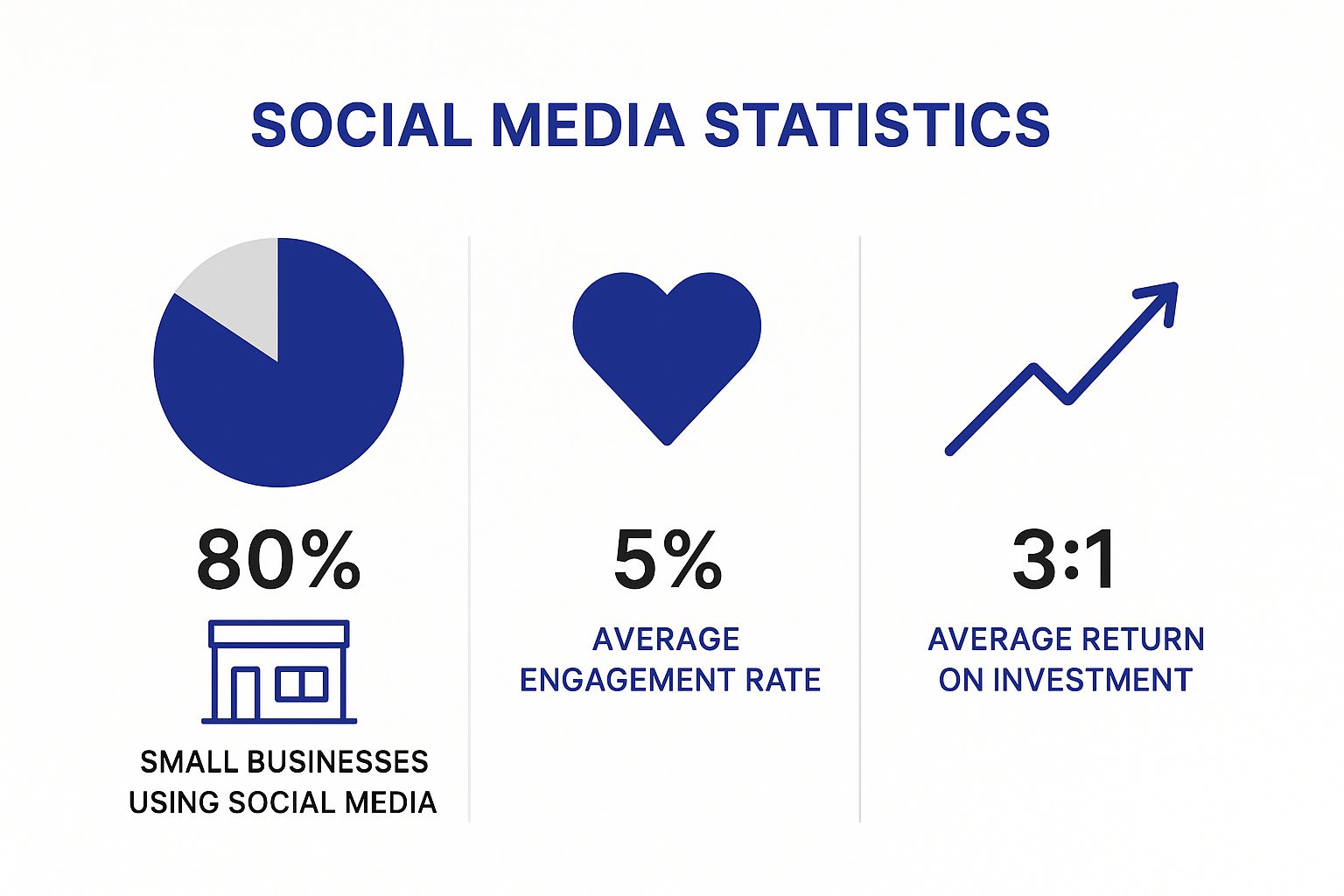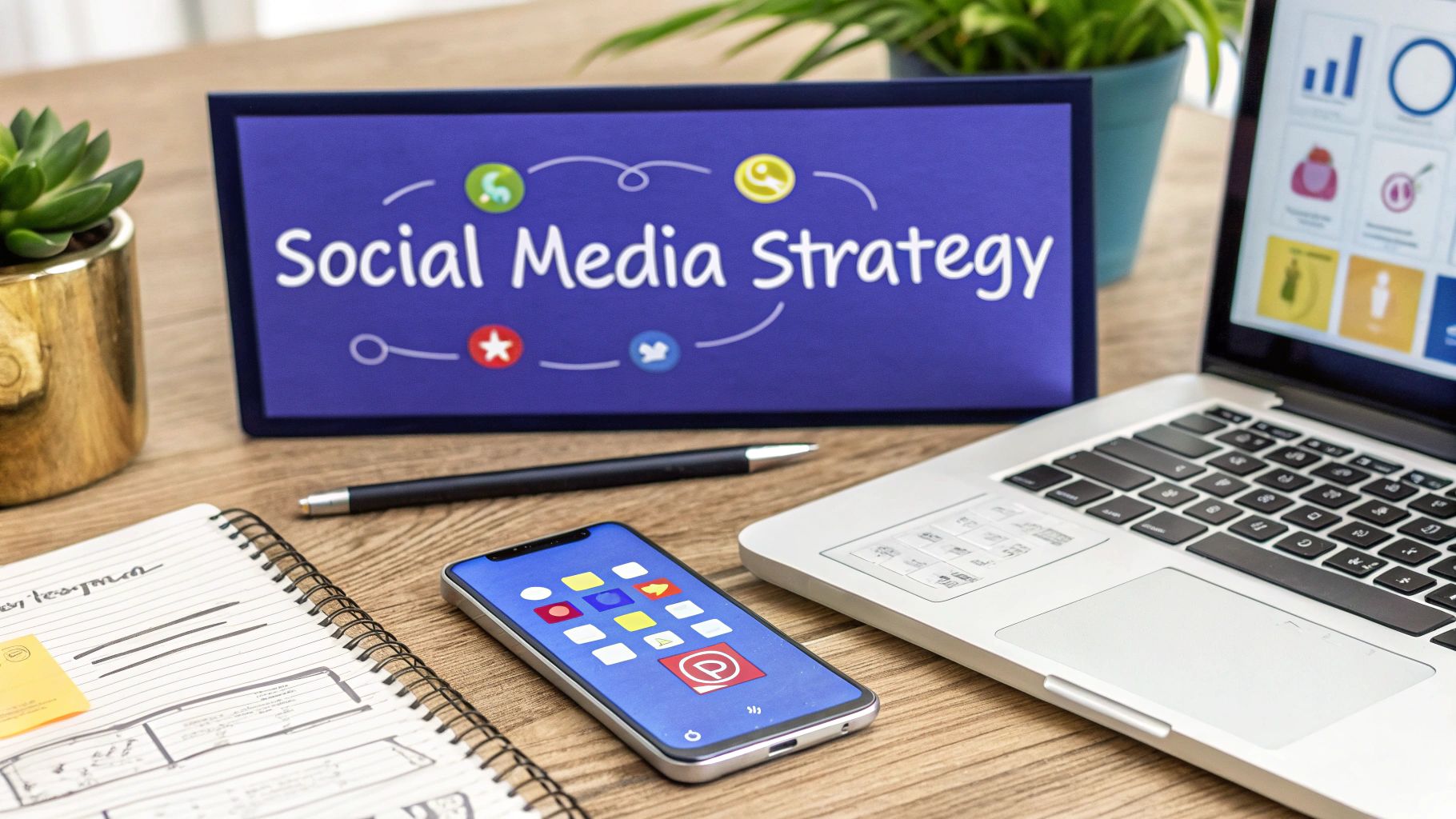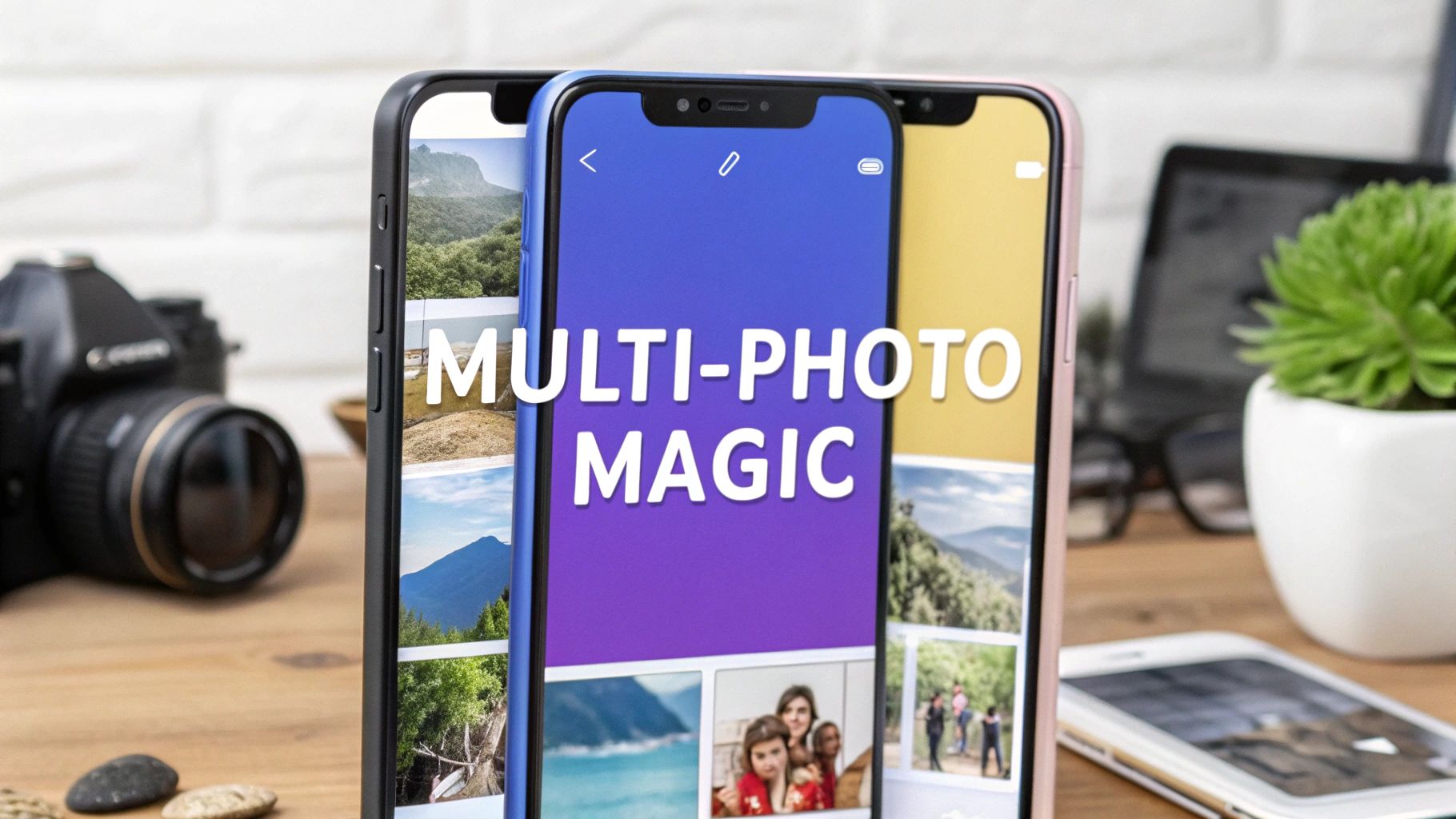A solid small business social media strategy is more than just a vague idea—it's your documented playbook. It connects everything you do on social media directly to your core business goals. Think of it as the blueprint that defines who you’re talking to, what you’ll share with them, and how you’ll know if it’s actually working. Done right, it turns a daily chore into a predictable engine for growth.
Why "Winging It" on Social Media Is Hurting Your Business
Let’s be real. Just “being on social media” isn’t a strategy. For so many small businesses, social media feels like a frantic, last-minute rush to post something—anything—just to keep the lights on. This scattergun approach feels productive in the moment, but it’s a silent drain on your most valuable resources: your time, your energy, and your money.
When your efforts aren’t tied to a real plan, they’re just noise.
The risks of this random approach are bigger than you think. Inconsistent messaging confuses your audience and dilutes your brand. One day you post a funny meme, the next a hard-sell promo, and the day after that? Crickets. This kind of randomness makes it impossible to build the trust and connection you need for customer loyalty. It’s like changing your storefront sign every single day—no one will know what you stand for or why they should choose you.
The True Cost of Inconsistency
Wasted resources are the most painful consequence of flying blind. Every hour you spend agonizing over what to post, every dollar you boost on a post with no clear objective, and every missed opportunity to connect with a potential customer—it all adds up. It’s a vicious cycle that leads to burnout, making social media feel like an obligation instead of an opportunity.
A formal small business social media strategy completely flips this dynamic. It takes social media from a reactive, time-sucking task and turns it into a proactive, reliable system for growing your business.
A strategy isn't about being restrictive; it's about being intentional. It ensures every piece of content you create and every interaction you have serves a specific purpose that moves your business forward.
From Random Acts to a Growth Engine
A strong strategy gives you clarity and focus. It forces you to get honest about the big questions:
- Who are we actually talking to? Defining your ideal customer ensures your content hits home instead of falling flat.
- What are our business goals? Tying social media to goals like lead generation or brand awareness makes your efforts measurable.
- What platforms really matter? You don't need to be everywhere. A strategy helps you focus on the channels where your customers actually hang out.
- How will we measure success? Ditching vanity metrics like "likes" lets you track what truly impacts your bottom line, like website clicks and sales.
The proof is in the data. This infographic gives you a bird's-eye view of the social media landscape, showing just how many businesses are using it and the massive potential for engagement.

The opportunity here is crystal clear: while most businesses are on social media, the ones with a real strategy are the ones capturing meaningful engagement and seeing a tangible return.
To see the difference in black and white, let's compare the two approaches.
Ad-Hoc Posting vs Strategic Approach
| Aspect | Ad-Hoc Approach (Without a Strategy) | Strategic Approach (With a Plan) |
|---|---|---|
| Effort | High stress, last-minute, reactive | Planned, efficient, proactive |
| Content | Inconsistent, random, often off-brand | Cohesive, purposeful, on-brand |
| Audience | Confused, disengaged | Engaged, loyal, clear on brand value |
| Results | Unpredictable, hard to measure, low ROI | Measurable, predictable growth, high ROI |
| Resources | Wasted time, money, and energy | Optimized and focused on what works |
The table makes it obvious. One path leads to frustration and burnout, while the other leads to sustainable growth. The choice of which path to take is entirely up to you.
The shift toward strategic social media is no longer a trend; it's the standard. Industry data shows that by 2025, an estimated 90% of all small local businesses globally will have integrated social media into their marketing. Even more telling, 78% of these businesses report that social media directly drives revenue, proving it's a core business function, not just a nice-to-have. You can find more details on how small businesses are winning with social media marketing in Thunderbit's latest findings.
Setting Goals That Actually Drive Business Results
Let's be honest. A social media strategy without clear goals is just... posting. It's like driving without a map—you're definitely moving, but you have no clue if you're getting any closer to your destination. To make social media work for your small business, you need to move past fuzzy wishes like "get more followers" and set concrete goals that directly fuel your growth and bottom line.
Forget the vanity metrics. Likes and follower counts feel good, but they don't pay the bills. Instead, we need to focus on goals that create tangible, profitable outcomes. This is where the SMART framework isn't just a corporate buzzword; it's your most valuable tool for turning social media activity into real results. It ensures your objectives are Specific, Measurable, Achievable, Relevant, and Time-bound.
The SMART Framework in Action
So, what does this actually look like for a small business? Instead of a vague goal like, "I want more leads," a SMART goal has teeth.
For example, a B2B consultant could transform that wish into a powerful objective: "Generate 50 qualified leads through LinkedIn direct messaging by the end of Q3."
See the difference? It's specific (leads from LinkedIn), measurable (50), achievable, relevant to business growth, and time-bound (end of Q3).
The difference between a wish and a goal is a deadline and a metric. A clear, documented goal transforms your social media from a daily chore into a predictable system for attracting customers.
As you map out your goals, remember that driving people to your website is often a huge piece of the puzzle. It’s worth exploring complementary strategies to get more website traffic to amplify what you're doing on social. A solid plan is everything, whether you're starting from scratch or just trying to get better results. If you want a structured place to start, our social media marketing strategy template can give you a solid foundation to build upon.
Defining Your Ideal Customer
Once you know what you want to achieve, the next critical question is who you're trying to reach. Shouting into the social media void is an expensive and frustrating way to market your business. To build real connections and drive action, you need to have meaningful conversations with the right people.
This all starts with creating detailed customer personas.
Think of a persona as a semi-fictional profile of your ideal client, pieced together from real data and a bit of educated guesswork. It goes way beyond basic demographics to uncover their motivations, challenges, and online habits.
To build out your personas, start with what you already know. Look at your current customer base—who are your absolute best, most profitable clients? Hunt for common threads in their:
- Demographics: Age, location, job title, income.
- Pain Points: What problems keep them up at night that your business solves?
- Online Habits: Which social media platforms are they actually on? What kind of content do they love and share?
Next, do a little friendly snooping on your competitors' audiences. Who is engaging with their posts? You can learn a ton by observing the questions people ask and the topics that get them talking. Finally, dive into the analytics tools built right into each social platform. They offer a goldmine of data about the people who already follow and interact with you.
By piecing this all together, you create a crystal-clear picture. For instance, a local bakery might identify "Busy Mom Brenda"—a 35-year-old working parent who values convenience, loves her community, and follows local foodie accounts on Instagram to find quick, healthy treats for her family. Armed with this knowledge, the bakery can craft content that speaks directly to Brenda’s world, making their social media efforts infinitely more effective.
Choosing the Right Platforms for Your Business
 Feeling the pressure to be on every single social media app? I see it all the time with small business owners. It’s a classic case of FOMO (fear of missing out) that leads to a scattered, ineffective strategy. You end up stretched thin, pushing out mediocre content on a dozen platforms instead of creating excellent content for the one or two that really matter.
Feeling the pressure to be on every single social media app? I see it all the time with small business owners. It’s a classic case of FOMO (fear of missing out) that leads to a scattered, ineffective strategy. You end up stretched thin, pushing out mediocre content on a dozen platforms instead of creating excellent content for the one or two that really matter.
Let's kill that habit right now.
A smart small business social media strategy is all about depth, not breadth. The goal isn't to be everywhere. It's to be where your ideal customers are and to show up in a way that genuinely connects with them. Trust me, it's far better to master a couple of channels than to be a ghost on five.
Where Does Your Audience Actually Live Online?
First things first: go back to those customer personas you worked on. Where do they actually spend their time scrolling? It doesn’t matter if TikTok is the hottest thing since sliced bread if your target audience of CFOs is busy networking and reading industry news on LinkedIn.
Think about your ideal customer’s daily routine. Are they scrolling through visual inspiration for their next home renovation? Or are they looking for a quick, funny video to watch on their lunch break? The single most important decision you'll make is aligning your platform choice with their existing habits.
Stop trying to drag your audience to a platform they don’t use. Instead, set up shop on the digital street corners where they already gather. Your resources are too precious to waste on trying to change user behavior.
This focused approach has never been more critical. The social media world is massive, with 5.42 billion users worldwide, but this audience is sliced into countless niches. The average person bounces between nearly seven different social networks every month, which means you have to be selective to cut through the noise. You can dig into more of the data behind this in these detailed social media statistics.
A Quick Guide to the Major Platforms
Every social network has its own vibe—its own culture, content style, and user base. Understanding these nuances is the key to picking the right one. Let's break down the major players from a small business owner's point of view.
- Facebook: Still the giant in the room, Facebook is incredibly versatile. It's fantastic for building community through Groups, sharing detailed updates, and running laser-focused ads. A local service business, like a plumber or an electrician, can build a ton of local trust and gather valuable reviews here.
- Instagram: This is a visual-first powerhouse. If your business has a strong aesthetic—think bakeries, fashion boutiques, or home decor shops—being on Instagram is non-negotiable. Features like Stories and Reels are perfect for showing off behind-the-scenes content and making your products look irresistible.
- LinkedIn: The undisputed B2B champion. If you're a consultant, coach, or any service provider targeting other businesses, this is your professional playground. LinkedIn is the place to share industry insights, network with decision-makers, and establish yourself as an authority in your field.
- TikTok: The king of short-form, authentic video. The TikTok algorithm loves creativity and relatability more than polished, high-budget productions. Businesses that can be entertaining, educational, or just plain human—from a law firm simplifying complex topics to a cleaning service with satisfying "before-and-afters"—can find explosive organic reach.
- Pinterest: Think of Pinterest as a visual search engine where people go to find inspiration and plan purchases. It's a goldmine for niches like weddings, recipes, home improvement, and DIY crafts. Plus, Pins have a much longer lifespan than posts on other platforms, driving traffic to your site for months or even years.
Making Your Final Decision
Okay, let's put this into practice. Don't just pick a platform because you've heard it's popular. Choose it because it makes sense for your business goals and plays to your content strengths.
Consider these real-world scenarios:
- A Local Bakery: Your best assets are the delicious, eye-catching photos of your pastries and cakes. Instagram is your #1 platform for showing off daily specials with beautiful photos and Reels. Facebook comes in second for building a local community, posting event info, and running ads targeted to people in your town.
- A B2B Marketing Consultant: Your goal is to land high-value clients and build authority. LinkedIn is your top priority, no question. You’ll be sharing in-depth articles, commenting on industry news, and connecting directly with potential leads. You might use X (formerly Twitter) as a secondary channel to jump into real-time conversations with other marketers.
Pick one to three platforms to start. That’s it. This focused approach gives you the time and creative juice to make high-quality content that actually gets results. Once you've got those down, you can always think about expanding.
Building a Realistic Content Creation System

Any good small business social media strategy hinges on its content. But let's get one thing straight: "great content" shouldn't mean you're chained to your desk 24/7. In my experience, burnout is the number one killer of consistency. The real goal is to build a smart, sustainable system that lets you work smarter, not harder.
The secret isn’t more hustle; it’s a better plan. It all starts with ditching the daily "what on earth do I post today?" panic and embracing a more structured, forward-thinking approach.
Establish Your Core Content Pillars
First things first, you need to define your content pillars. These are the 3-5 core themes your brand will own and talk about consistently. Think of them like the main sections in your brand's own magazine. Every single thing you post should tie back to one of these pillars, which keeps your messaging focused, relevant, and unmistakably you.
Let’s say you run a local fitness studio. Your pillars might look something like this:
- Workout Tips & Form: Short, snappy videos showing people how to do an exercise correctly.
- Nutrition & Recipes: Simple, healthy meal ideas that actually support your clients' fitness goals.
- Member Spotlights: Celebrating the real stories and progress of the people in your community.
- Behind-the-Scenes: Introducing your trainers, showing off the studio's vibe, and making your brand more human.
Suddenly, you have creative guardrails. Instead of staring at a blank canvas, you have specific buckets to fill with ideas. It makes the whole process feel much less intimidating.
A content pillar system turns brainstorming from a huge, open-ended chore into a simple "fill-in-the-blanks" exercise. You stop creating random posts and start building a library of expertise around what you do best.
The Power of Batching and Repurposing
Once your pillars are locked in, you can tap into two of the most powerful productivity hacks I know: batching and repurposing.
Batching is just a fancy word for creating a ton of content in one dedicated block of time. Instead of scrambling to shoot a video every single day, you set aside one afternoon to film all four videos you need for the month. This approach is a game-changer because it slashes the time you waste switching between tasks. You get into a creative flow and knock out all the setup, filming, and editing in one efficient session.
Repurposing is the art of squeezing every last drop of value out of a single piece of content. One great idea can be sliced, diced, and remixed for different platforms. This is how you maintain a strong, active presence without constantly having to reinvent the wheel.
Here’s a real-world example of how one customer success story can fuel your content for a week or more:
- Long-Form Blog Post: A detailed case study published on your website.
- Video Testimonial: A powerful 60-second clip for YouTube and Facebook.
- Instagram Carousel: A multi-slide post highlighting the key results and before/after stats.
- Quote Graphics: Pulling out the customer's best one-liners for visually engaging posts.
- LinkedIn Article: A more professional summary focused on the specific business problem you solved.
When you combine batching with repurposing, you're not just creating content; you're building a content engine that churns out quality posts with a fraction of the daily effort.
Finding the Perfect Content Mix
To keep your audience engaged and actually moving toward a sale, you need a balanced diet of content. Not every post can be a direct sales pitch—that’s a surefire way to get unfollowed. A healthy strategy mixes educational, entertaining, and promotional posts.
A great rule of thumb is the 80/20 principle. Make sure 80% of your content provides genuine value (teaching or entertaining your audience) and only 20% is directly promotional. This builds massive trust and positions you as an expert resource, not just another company trying to sell something.
And don't sleep on User-Generated Content (UGC). Actively encouraging your customers to share photos or experiences with your product is one of the most authentic marketing tactics out there. When you reshare UGC, you get free, high-trust content and build a powerful sense of community around your brand.
Of course, all these ideas, pillars, and schedules need a home. A well-organized content calendar is non-negotiable for a smooth workflow. To get started, check out our guide on how to create a social media calendar that pulls everything together—your pillars, your batching schedule, and your posts—all in one place. It’s the final piece of the puzzle for building a content system that truly works.
Using Automation and AI to Work Smarter
A killer small business social media strategy doesn't require you to be chained to your phone 24/7. Frankly, the smartest thing you can do is let technology handle the grunt work. Doing so gives you back your most precious resource: time. Automation and AI aren't just for mega-corporations anymore; they're the secret weapon for small teams that need to make a big impact.
The point isn't to let a robot take over your brand. It's to free yourself from the repetitive, time-sucking tasks so you can focus on what actually matters—talking to your customers, building a real community, and creating content that people genuinely love.
The Essential Tech Stack for Small Businesses
Diving into social media tools doesn't have to be overwhelming or break the bank. Just think of it as building a small but mighty toolkit, where every tool has one specific, important job.
You can get a massive amount of leverage with just three types of tools:
- Scheduling Tools: Platforms like Buffer or Later will quickly become your best friends. They let you plan and create your content in batches, then automatically post it at the best times. This single move frees you from the daily panic of "What should I post right now?"
- Simple Design Tools: You absolutely do not need a graphic design degree to create eye-catching visuals. A tool like Canva is packed with thousands of dead-simple templates for Instagram stories, Facebook posts, and anything else you can think of. It’s the fastest way to make your brand look polished and professional.
- Analytics and Listening Tools: Knowing what’s working (and what’s not) is everything. The built-in analytics on each platform are a good start, but a dedicated tool can bring all that data into one place. Many, like the ones offered by PostSyncer, also let you track mentions of your brand or keywords, giving you a crystal-clear view of your performance and what your competitors are up to.
Technology should serve your strategy, not define it. The right tools handle the tedious work, so you can focus on the human side of social media—the part that actually builds trust and drives sales.
Putting Generative AI to Practical Use
Beyond simple scheduling, generative AI has become an incredible creative sidekick for small businesses. Instead of battling writer's block, you can use AI to jumpstart the whole content creation process and claw back hours every single week. The secret is to give it specific, detailed prompts to get quality results.
Think of AI as your new junior copywriter or brainstorming assistant.
For instance, a local coffee shop could feed it this prompt to get some fresh ideas for Instagram: “Act as a social media manager for a cozy, community-focused coffee shop. Our target audience is remote workers and local college students. Brainstorm 10 catchy opening hooks for an Instagram Reel showcasing our new pumpkin spice latte. Focus on sounds, smells, and the feeling of autumn.”
The AI will spit out a list of starting points. You can then take the best ones, tweak them, and inject your shop’s unique personality. The AI does the initial heavy lifting, and you provide the final, human touch. This works for everything from drafting post captions to outlining video scripts.
Spotting Trends with AI-Powered Social Listening
One of the biggest advantages tech gives a small business is the ability to "listen" at a massive scale. AI-powered social listening tools are constantly scanning social media for any mention of your brand, your competitors, or important topics in your industry. For a small team, this is like having a market research department working for you around the clock.
This isn't just a small perk; it's a huge competitive edge. The data shows that 90% of businesses are now using generative AI to save time and make better content. And it pays off—73% of them report a clear boost in engagement. Even better, teams that use social listening tools are twice as confident in their marketing ROI as those who don't. You can see more stats on how AI is changing the game and understand why it's become so essential.
By setting up alerts for key terms, you can catch new trends before they explode, jump on customer feedback in real-time, and find conversations you should be a part of. It shifts your entire strategy from being reactive to proactive, letting you make smarter decisions that keep you one step ahead.
Measuring What Matters to Grow Your Business

Here's where the rubber meets the road. A great small business social media strategy isn't a "set it and forget it" task. The final, and arguably most important, piece of the puzzle is tracking real, tangible results. It's time to graduate from vanity metrics like likes and follower counts and start focusing on the numbers that actually move the needle for your business.
Your social media efforts are only as valuable as the outcomes they drive. That means tying every metric back to the specific business goals you defined earlier. If your goal was to increase sales, then metrics like click-through rate (CTR) on product links and website conversions are your new best friends. If you wanted to build an engaged community, then comment sentiment and share counts tell a much richer story than a simple like ever could.
Finding the Right Numbers
You don’t need to invest in a pricey, complex analytics suite to get started. Honestly, every major social platform already gives you a goldmine of data for free through its own native analytics dashboard. Your Instagram Insights or Facebook Business Suite, for example, can quickly show you which posts drove the most website clicks or had the highest reach.
Spend some real time digging into these tools. Look for the patterns that emerge from your best content.
- Which posts earned the most shares or saves?
- What time of day are your followers actually online and active?
- What format (video, carousel, static image) consistently gets the best reactions?
The goal isn’t just to collect data for the sake of it; it's to find actionable insights. Your analytics should tell you a story about what your audience truly wants, guiding you on what to create more of and what to ditch.
When it comes down to proving the value of all this hard work, you have to connect your creative efforts directly to your bottom line. It all starts with understanding the ROI of content marketing.
Your Strategy Is a Living Document
Think of your social media strategy as a living, breathing plan—not a static document you create once and then file away to collect dust. It needs to evolve as you learn what works. The best way to make sure it stays effective is to build a simple, consistent review process.
Set aside a little time once a month for a quick check-in. During this review, just ask yourself three simple questions:
- What Worked? Pinpoint your top 3-5 posts from the past month. What do they all have in common?
- What Didn’t? Now look at your lowest-performing content. Be honest—why do you think it fell flat?
- Are We on Track? How are you progressing toward the main business goals you set?
This straightforward, data-driven approach is what allows you to constantly refine your strategy. You’ll learn, adapt, and improve, making sure your social media presence continues to deliver real, measurable results for your business.
For a deeper look into the specific metrics you should be tracking, you can learn more about https://postsyncer.com/blog/how-to-measure-social-media-success in our detailed guide.
Answering Your Top Social Media Strategy Questions
When you're finally ready to put a formal plan into action, a few common questions always seem to pop up. I hear them all the time from small business owners. Let's tackle these roadblocks with some practical, real-world answers so you can confidently manage the day-to-day of your new small business social media strategy.
How Much Time Should I Actually Spend on Social Media?
There's no single magic number, but a solid starting point is 3 to 5 hours per week. This isn't about mindless scrolling; it's focused, intentional work.
The key to making this manageable is to work smarter, not harder. I always recommend content batching and using a scheduling tool. For instance, you could block out one hour to create all your content for the week, then spend just 30 minutes each day on genuine engagement—that means responding to comments, answering DMs, and interacting with other accounts in your niche.
What Do I Do About Negative Comments?
Whatever you do, don't ignore them. Ignoring negative feedback is almost never the right move. The trick is to respond quickly, publicly, and professionally.
Start by acknowledging their concern with empathy. Then, offer to take the conversation to a private channel like DMs or email to sort out the specifics. This approach shows everyone else that you're responsive and genuinely care about finding a solution, all while preventing a messy public argument.
A prompt, calm response to a negative comment can often turn a dissatisfied customer into a loyal advocate. It demonstrates a level of transparency and commitment to customer service that your entire audience can see.
Should I Hire Help or Do It Myself?
When you're first starting out, I strongly believe that managing social media yourself is the best way to truly understand your audience and nail down your brand's voice. After all, nobody knows your business better than you do.
However, there comes a point where you've got a proven strategy, you're making money, but you're just out of time. That's the perfect moment to hire a freelancer or a virtual assistant. It frees you up to get back to the core activities that only you can do in your business.
Ready to implement a smarter strategy without the burnout? PostSyncer centralizes your scheduling, analytics, and content creation with powerful AI tools. Take control of your social media and get your time back. Start your free trial.















